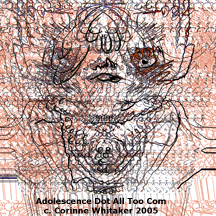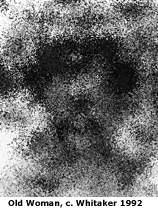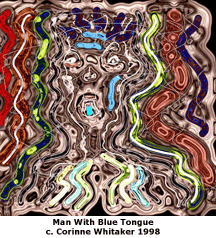
How to Play the Trombone
I've had two formal teachers in my art career (aside from Life itself, which I tend to stumble over from time to time, like three stumble-down marriages). My less favorite of the two was an artist who imploded when I out-ranked him in an art competition. (He never forgave me.) But he taught me to discard perfect images and concentrate on the failures.

I mention this because so many people are entering the computer imaging world with the idea of learning rules. I have a hard time convincing them that there are no rules. Oh, you don't want to leave your filled coffee cup near your computer. And it helps to take a break every so often - pump iron, walk the parakeet, or circumnavigate your soul - but that's about it. They find it hard to believe that the world of digital imaging is still in diapers, that in fact we have no clue where it will be in fifteen or even five years. They see digital art as a structured system, virtually impenetrable to newcomers and incomprehensible to all but technorati and cronked teens.
As comforting as it may be to think that someone out there has the answers, it just isn't so. We are all learning, even those like myself who began 28 years ago. The field is wide open, a big box of candy just waiting for you. If you want to follow rules, buy yourself a paint brush. Or better yet a spreadsheet program.

But for creative minds, the answer lies in play. Beauty hides in the unknown spaces. How do I, personally, play? First by being hopelessly curious, and irretrievably stubborn. (My Dad used to say, if you want her to use a fork, insist that she use a spoon.) If a program says "draw a square" I draw a circle. If it offers me a number from 1 to 55 I choose 79. My mantra is "why not?". Manuals bore me. Too many of them are translations from another language and simply make no sense. I look for new narrative paths that the software engineers didn't envision. That's why they used to be astounded when they visited the Digital Giraffe gallery in Carmel - they had no clue what their software could produce in the hands of an artist. They were caught in the profit-making snare. I could wander through the mazes and play to my heart's content.
Back in the stagecoach era, when we had virtually no graphics applications, I wrote to the National Supercomputing Center in Illinois and purchased a program on thermal properties, a subject which I knew nothing about. It was based on mathematical equations, so I began feeding irrational equations into my computer. Most of the time I got some fairly lethal epithets about my arithmetical talents, but every so often a stunning graphic would appear and I would use it as the basis for a piece. My engineering friends always wanted to know what equation I had used. They were dismayed to learn that I had trashed the equations: as an artist I never wanted to repeat myself.
When electrostatic tablets appeared, I began doodling. I produced hundreds of scribbles, first with my dominant hand, then with the non-dominant. I looked at how they differed. I kept my eyes closed in order to draw from within rather than copy from without. I began to see what role intention and experience played in drawing. (Were I to do that exercise today I'd probably follow the non-dominant scribbles to see what unknown spaces they would lead me to.)

When primitive fractal programs became available, but only in black and white, I played between the interstices until color showed its face. When basic raster and vector apps were restricted to two dimensions I found a way to force them into some crude three dimensionality. I was experimenting, making wild marks, but always, always, playing.

One day soon you will find Specialists in Digital Imaging, teaching strict adherence to rules as the foundation of the new discipline. They will use big words enveloped in big thoughts ensconced in big volumes. That's fine. But in my world rules are made to be smashed and transcended. (If you doubt me, read what Sol LeWitt had to say on the matter in this month's ArtSmart Quiz.) In the meantime, if you want to learn computer imaging, first stand on your head. Crawl on your belly to see what the world looks like to a worm. If you get criticized, tell Alice with her malice to go jump in a rabbit hole. You have before you a giant orchestra of 776 trombones. Just pick one and start to play. You see, the play's the thing (but someone already said that didn't he? Let's see: what if the play were a non-thing, and the words danced on squashed tomatoes, and the audience sang in tongues while the actors snored and the donkeys brayed......).
That's how I play the trombone.
c. Corinne Whitaker 2009